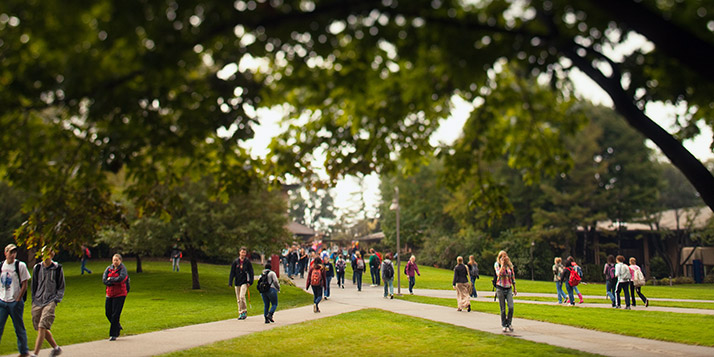Calvin’s arboreal residents reached celebrity status earlier this month as Calvin College became Michigan’s third school to receive recognition as a tree-friendly campus.
The recognition comes through a program called “Tree Campus USA,” launched in 2008 as a partnership between the Arbor Day Foundation and Toyota. The initiative honors colleges and universities that commit to mindfully managing campus forests and facilitating ecological awareness and action in their campus communities.
The program landed on Calvin’s radar several years ago, after faculty members Dave Warners and Gail Gunst Heffner attended a Tree Campus USA workshop at a conference. Biology professor Warners had already been heavily involved in campus sustainability issues alongside Heffner, Calvin’s director of community engagement. Intrigued, they pitched the idea to Bob Speelman, a certified arborist and Calvin’s supervisor of landscape operations at the physical plant.
This wasn’t the first time Calvin’s trees had been in the spotlight. In 2010, Warners teamed up with geography professor Jason VanHorn to orchestrate a campus tree inventory. Using data collected by Warners’ and Van Horn’s students, then-sophomore Owen Selles spent summer 2011 generating a searchable online tree map. An attempt toward tree-friendly recognition seemed a logical next stage.
In spring 2012, Heffner, Speelman and Warners recruited other interested parties and launched a campus tree committee. The committee played dual roles by addressing future steps toward Calvin’s Tree Campus recognition — and by being that first step.
In addition to creating a campus tree committee, Calvin had to meet four other goals: developing a tree management plan, allocating budget funds to the tree program, organizing annual Arbor Day events and coordinating relevant service-learning projects for students and faculty.
The tree committee members lost no time in fulfilling the third and fourth requirements. They turned to the Plaster Creek Stewards, a collection of Calvin and Grand Rapids community members dedicated to restoring the ailing local water body known as Plaster Creek.
Heffner is a member of the Plaster Creek Stewards leadership team. She recounted that, in spring 2012, “we focused [our] spring event on the importance of trees for a healthy watershed” in honor of Arbor Day — and in compliance with the Tree Campus guidelines. “Then, one option for participants to choose from during the restoration component of the spring event was tree planting,” she continued.
When the tree management plan and budget were complete, the tree committee submitted their nomination to the Tree Campus USA program, recommending that Calvin be considered for recognition. On March 1, 2013, the committee’s work paid off, and Calvin received official recognition from Tree Campus USA.
Calvin’s Tree Campus designation should require little annual upkeep. Much of the legwork will come from Speelman’s coworkers at the physical plant. “Continuing to be a Tree Campus will not be difficult now that all the processes are in place,” said Speelman. Warners added, “It’s pretty much just making sure we have an event each year and keeping the plan updated and the committee running.”
The Tree Campus designation allows Calvin to showcase the positive tree management plans already in place at the Physical Plant. With increased awareness of the campus tree care plan, Speelman said, “The Calvin community can be assured that all tree removal decisions are made with a wealth of experience, training and input from others.”
The Tree Campus USA recognition sets Calvin apart from its scholastic peers. Following the University of Michigan and Western Michigan University, Calvin is the third school in the state to receive the Tree Campus designation.
“It is public recognition that the people at Calvin are intentional about taking care of the trees on their campus,” said Warners. “In this way, it provides applied evidence that we do want to take our stewardship responsibilities seriously.”
Aside from being tied to a Christian Reformed worldview, those stewardship responsibilities translate to real-time campus benefits. Healthy trees, said Speelman, “provide oxygen, sequester carbon, intercept stormwater, and lower building and parking lot temperature.” They also buffer wind patterns, provide excellent climbing opportunities and are much more interesting to look at than the average red-brick wall.
And they’re everywhere. With more than 3,500 trees, “Calvin’s campus can really be seen as a park,” said Speelman. “We have the opportunity to plant large trees that often grow unimpeded for years to come. I was told once that, at best, myself and [Calvin’s ground crews] will only care for some trees for a third or less of their lifespan.”
The designation carries ideological significance, too. “I would hope it might cause students to think a little differently about the trees they pass by everyday,” commented Warners. “These are not simply left overs that someone didn’t get around to cutting down, or potential resources defined by board feet. They add beauty and texture to our place … many of them have important historical or ecological significance.“
To honor Calvin’s Tree Campus USA designation, a celebration will be held during the Calvin Environmental Assessment Program’s spring poster session on May 8 at 4:30 p.m. At the poster session, Mayor George Heartwell will present the keynote speech on “Reaching New Levels of Sustainability for Grand Rapids.”









